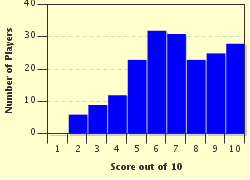Quiz Answer Key and Fun Facts
1. Friction seems to play a role in just about everything, and it certainly plays a part in bowling a strike. Which of these, for most bowlers, creates the most kinetic friction with the bowling ball?
2. Bowling pins are shaped in a certain way so they are more stable and less likely to fall over if gently hit. This is because of their center of gravity, which is located where in the pin?
3. The momentum of the bowling ball also plays an important role in getting all ten pins to fall over and gain a strike. In the common equation p=mv, which of the symbols represents momentum?
4. There is science behind everything in bowling, including the spin of the ball down the lane. Bowlers use special balls with spin, or create the spin themselves, to hit the pins at an angle. What do bowlers call this spin?
5. The pins' center of gravity is important, but so is the bowling ball's. Because a bowling ball is completely spherical, the center of gravity is in the exact center of the bowling ball.
6. Both potential and kinetic energy can be at play while bowling a strike. While the bowling ball is rolling down the lane, it is exhibiting kinetic energy. Is this correct?
7. Keeping in mind all aspects of physics, as your bowling ball travels down the lane, using the laws of acceleration, what is the ball doing?
8. As it turns out, the weight of the ball plays a role in bowling. Of course, the lighter the ball, the easier a spin can be applied and the more control one has. However, a heavier ball also has more power, so it will more easily knock the pins down (having a greater force, if you can manage to throw it hard enough).
Of course, if we were to hop in a rocket and take our bowling balls and pins to the moon, most everything about the bowling ball would remain the same, except for which of these properties?
9. Angular velocity also plays an important role in the physics of bowling. Which of these describes what is measured with angular velocity?
10. The time has finally come. The ball is going down the lane, and it hits the pins perfectly. You have achieved the lucky strike. Congratulations!
When the ball first hits the pins, this is known as a collision. With the laws of friction ignored, however, what kind of collision is it?
Source: Author
salami_swami
This quiz was reviewed by FunTrivia editor
CellarDoor before going online.
Any errors found in FunTrivia content are routinely corrected through our feedback system.

